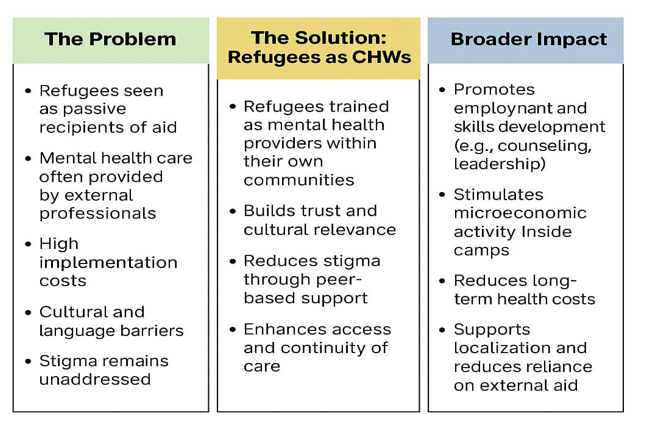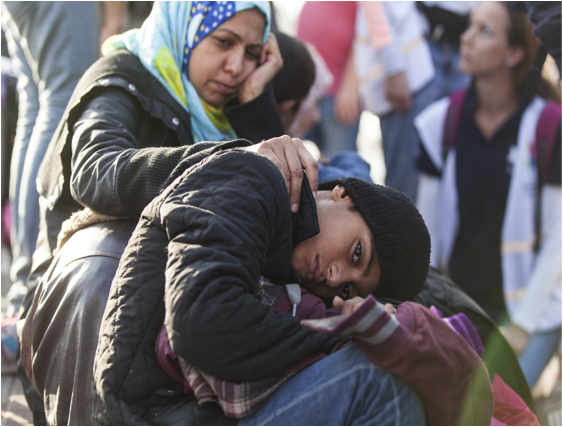During humanitarian crises, refugees are frequently perceived as passive beneficiaries of assistance. But this story is changing quickly, especially when it comes to mental health treatments. Our recent study examines a robust, community-driven model: enabling refugees to act as community health workers (CHWs), especially in refugee camps throughout the MENA region.

Figure 1. Refugee CHWs Model
Training refugees as community health workers paves the way for employment opportunities within the camp, and possibly outside. Trainees gain transferable skills in counseling, health communication, leadership, and basic diagnostics. This will improve individual livelihoods, stimulate the local camp economy, and encourage microeconomic activity through the creation of small-scale service networks, such as peer-led mental health support groups, informal training sessions, and partnerships with NGOs that may offer stipends or microgrants, thus generating localized income and reducing economic inactivity within the camp. It may also positively impact refugees upon their future return to their home country, as they will have gained experience that qualifies them to work in this field and reduce reliance on humanitarian aid, which involves bringing in specialists from outside the camp.

Figure 2. CHWs and Their Impact on SDG 3 and SDG 4
Amartya Sen’s “Capabilities Approach” says that justice in health is not just about providing services, but also about giving people more freedom to live dignified, independent lives. This is very similar to the work of refugee CHWs. Countries like Jordan, which already give refugees access to public healthcare, have a chance to expand this model as a way to deliver health from the bottom up, connecting policy, practice, and local empowerment. This model is not charity; it’s a sustainable and cost-effective development strategy. It aligns with the Global Compact on Refugees and the global shift toward localizing humanitarian responses by shifting from aid to development. Empowering refugee-led civic communication platforms could boost mental health interventions’ reach and credibility, especially in fragile social environments.
Recommendations: From Research to Action

Figure 3. From Research to Action: Key Enablers
- Innovative Financing Mechanisms
Donors and development stakeholders should consider outcome-based funding mechanisms, such as Development Impact Bonds, or hybrid financing models in which NGOs, such as UNHCR, Mercy Corps, and Humanity & Inclusion (HI), partner with local governments and private entities to sustainably train and retain refugee CHWs. These models reduce dependence on provisional grants and enhance accountability, especially when applied to areas like mental health support in refugee settings.
- Engaging Banks as Partners in Mental Health Solutions
By implementing creative financing models that combine healthcare with wider development goals, Jordanian banks can significantly contribute to this effort, particularly in areas related to education and empowerment of this group. Notably, in 2025, Jordanian banks collectively launched a national initiative to support the health and education sectors by allocating JD 90 million over three years as part of their social responsibility to promote national development and economic growth. This reflects the active and growing role banks can play in supporting health-related development efforts. For instance, banks in Jordan have previously demonstrated interest in mental health; in 2024, Cairo Amman Bank, through its “Signature” brand, supported an international event in Aqaba focused on women’s mental, physical, and spiritual health, highlighting the role of financial institutions in promoting psychosocial well-being and community empowerment. This momentum creates a strategic opportunity to institutionalize CHWs within the broader development framework while enabling banks to expand their social impact through inclusive, long-term partnerships.
- Development of Key Performance Indicators (KPIs)
Clear KPIs can help measure the effectiveness of CHWs. These may include the number of cases handled, referral efficiency, follow-up rates, client satisfaction, and improvements in the CHWs’ own economic conditions. Adapting these indicators to the Jordanian context would support practical implementation and inform policy decisions, especially if adopted by institutions specialized in performance measurement in Jordan, such as the Performance Index Center, as KPIs offer a structured basis for tracking progress and ensuring accountability.
- Civic Media and Social Impact
Jordan has launched several programs to support refugee mental health. The most recent is the Psychological Resilience Skills Program in schools for Syrian refugees, launched in 2025 by the Queen Rania Teacher Academy to promote psychosocial support practices. Along with these important programs, refugees can also lead storytelling and awareness campaigns that can change how people think about mental health, which can make community health workers’ work even more effective. NGOs and media organizations ought to work together to create campaigns that amplify the voices of CHWs both within and beyond the camps, an approach already embraced by local initiatives such as We Love Reading, which uses community-based storytelling to foster emotional resilience and social inclusion.
#Jordan #Refugees #CHWs #MentalHealthInCrisis #CommunityLedHealth #HealthForDignity #RefugeesEmpowered #LocalizationWorks #SDG3 #SDG4 #FromAidToDevelopment #HumanitarianInnovation #HealthJustice

